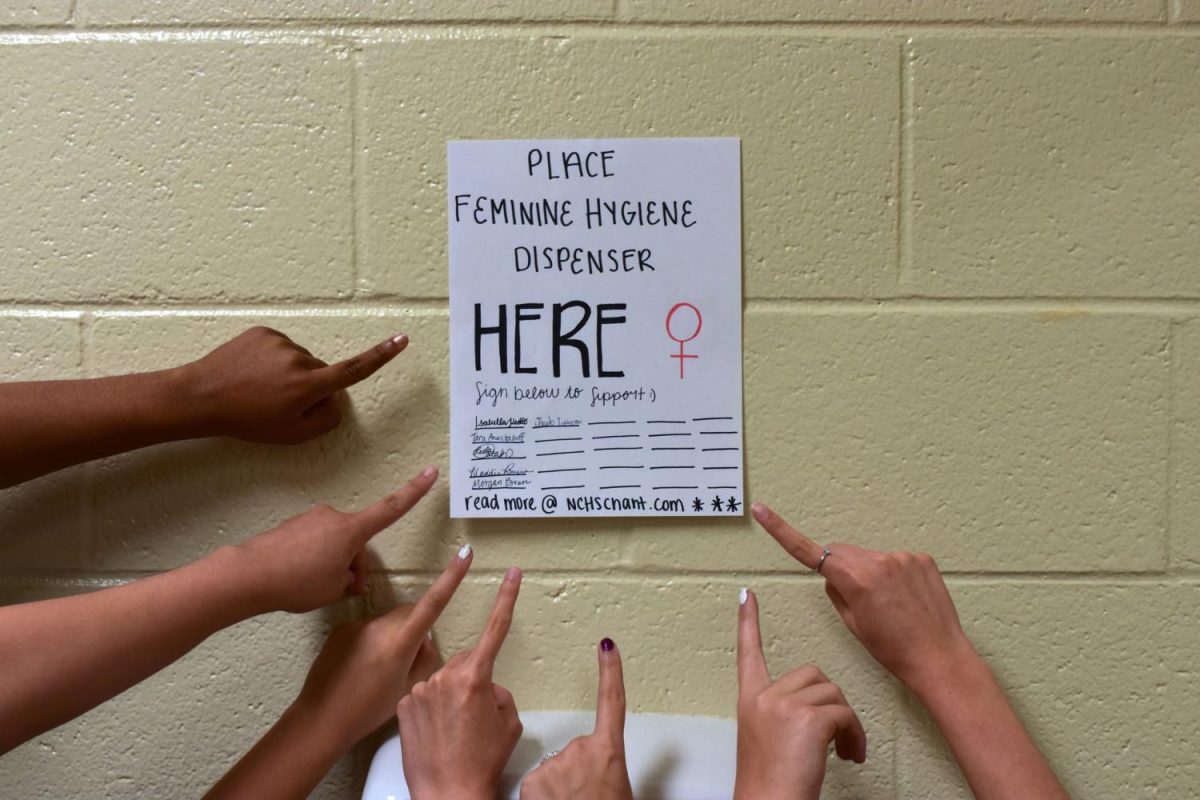The need for feminine hygiene dispensers in girls bathrooms at NC
Placed in the girl bathrooms of NC, feminine hygiene dispenser posters give students the ability to voice their own opinion. As girls go to the bathroom, they can pull out their pens and pencils to show support. The issue of the lack of accessibility of menstrual products becomes more evident as women start to speak up at NC.
October 2, 2017
Young women walk the halls of NC every day feeling self conscious of something they cannot control. On top of pushing through the troubles of high school, girls go through changes in their bodies.
The inability for others to understand feminine issues, such as distribution of tampons or sanitary pads, creates an uncomfortable and unwelcoming atmosphere for growing young women.
Ignoring these issues creates an unhealthy community that unfairly criticizes young women. The importance of distributing menstrual products lies in the hands of county administration, but they refuse to acknowledge this need.
As the demand for menstrual products overwhelms school nurse, Fikera Gerald, feminine hygiene dispensers become more and more popular. Showing up in places like malls and department stores around the county, the dispensers provide sanitary products for girls during a period emergency.
“I know there was another nurse from another school that was trying to promote the same kind of concept, but in a vending machine. She hasn’t gotten it to go all the way through yet, but these things are happening, and I think it is an amazing idea that could benefit so many young girls,” Nurse Gerald said.
Gerald provides panty liners for students with emergencies, but for girls with heavy-flow days, this does not work. Due to the Pink Tax and the overall cost of female menstruation care products, Gerald cannot keep up with the demands of the students on her own.
“Feminine products are costly and there are so many young women at NC that need the products. I just can’t keep up with the demand of the students because of the cost, so a dispenser would be amazing because the students would be paying very little for just one at a time whenever they would need it,” Gerald said.
The dispensers would allow students to use spare change to pay for their own products. Costs of the products in dispensers range from a dime to a quarter, depending on the size or type of product.
“It [Having a menstrual product dispenser] would save me from panicking and being nervous. I wouldn’t have to worry about it during class because girls get stressed out about that all the time. It also distracts you because you’re trying to contact friends for extra pads or tampons they may have,” sophomore Kelsey Dunn said.
However, Cobb County rules restrict NC from distributing tampons due to the side effects that may arise, such as Toxic Shock Syndrome (TSS). Girls also may not know how to properly insert a tampon, consequently causing damage. Since the county refuses to take liability for possible diseases or injuries, dispensers will exclude tampons.
Although Cobb County will not allow the distribution of tampons for fear of lawsuits, students contemplate how to move around the rule. A disclaimer placed on the outside of each dispenser about the warnings of using tampons informs students that they should use the tampons at their own risk. Labeled diagrams with instructions about how to properly use a tampon could also decrease potential injuries.
Students also fill out a medical clinic card at the beginning of each school year; adding a portion about the usage and distribution of tampons would provide parents with information.
“I feel like adding a disclaimer to the actual dispenser box would give the county what it needs in situations like this, also the nurse is always available as a resource for girls who may not know how to properly use a tampon,” Dunn said.
According to The Conversation, an estimated 42% of women use tampons compared to the 62% that use sanitary pads. While most prefer to use pads, tampons allow more movement and comfort to the student. Tampons give young women the mobility they need while participating in after school activities as well, exhibiting the urgency for their presence in dispensers as well.
Although tampons may remain excluded from dispensers, the idea gives anxious girls peace at mind. Leaving school to retrieve menstrual products in cases of emergencies gives girls a disadvantage in school, but the dispensers would allow the student to grab what they need, when they need it.







